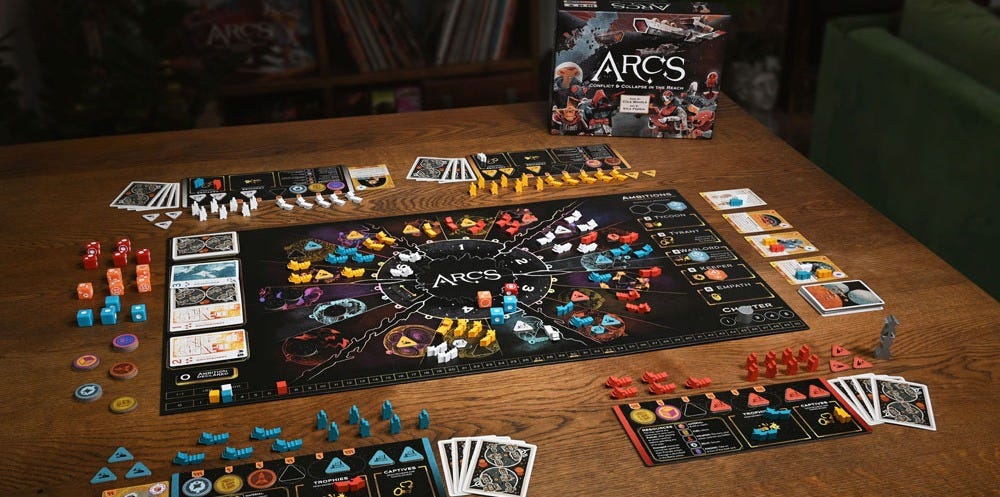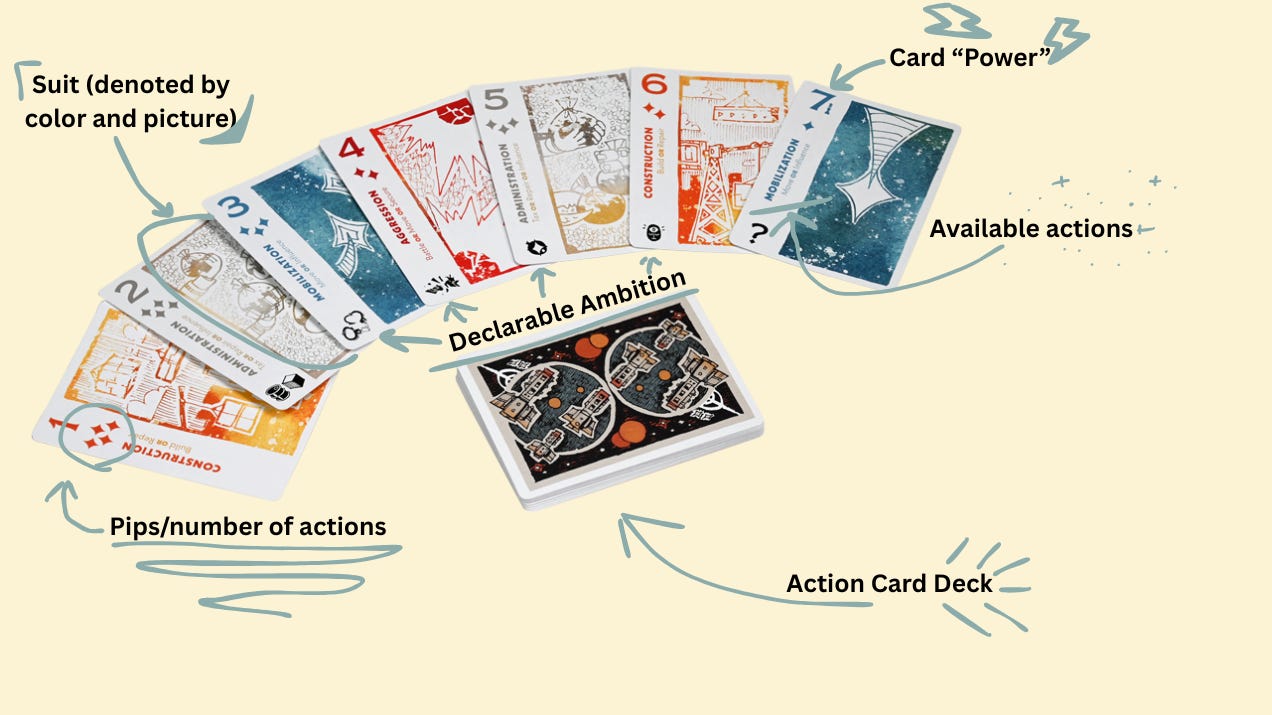This game has been talked about extensively. It’s been in the BGG hotness ever since being released in mid 2024. So why did I decide to release this? There’s been enough conversation around the game.
Here’s the thing. I’ve been writing this since my first game in September 2024. It’s a game that I’m almost constatly thinking about and I love it.
Because I’ve been working on this for so long, my thoughts might be a little bit scrambled. I hope you can enjoy this wildy unorganized and heartfelt review of Arcs.
Very few games make you feel like you’re controlling a tangible, real thing. In Wingspan, you’re building a biome of birds, in Azul, you’re laying tiles to create a mosaic, and in Viticulture, you’re in charge of a vineyard and winery.
These games are thematically on point, but the gameplay isn’t evocative of that theme, and that’s a good thing for those games. Those birds don’t go together, those tiles don’t look aesthetically nice, and there’s a lot more that goes into a vineyard.
But when a game’s themes match the gameplay?
Arcs: Thematics
“In Arcs, you lead a spacefaring society through an epic saga, as you try to survive in the harsh and dangerous Reach at the galaxy’s edge.”
This is the first sentence of the rulebook, and it’s what the game is all about.
You are in the seat of the Death Star. You are piloting the Millennium Falcon through lightspeed. You are that guy on a spaceship looking at holographic maps while your ship jumps through space.
You are seeking power in the deep reaches of space. It’s a new dawn, and it’s your responsibility to seize control. However, you’re low on tools.
GamePlay
The base game of Arcs is played in 5 chapters. Players are guaranteed to take 6 turns within these chapters, but that number can change. Every turn, players play a card, which dictates what they can do.
It’s hard to talk about how Arcs is played without first explaining the action cards.
The Action Cards
If you don’t like the action cards in Arcs, you probably won’t like Arcs. I, for one, think they are brilliant and make the game feel frenetic, fast, and tense.
These cards are how you do things in Arcs. Every turn, you’ll play 1 and do the actions it allows.
Administration: Tax, Repair, or Influence
Aggression: Battle, Move, or Secure
Construction: Build or Repair
Mobilization: Move or Influence
Alongside the actions you can do with the card, there is a card number on the top left and a group of pips. The pips denote how many of the actions you can do. So, if you play an Administration card with 4 pips, you can Tax, Repair, or Influence in any number of ways.
The “Trick Taking”
The card number on action cards is where things get a little interesting.
The game is played in chapters, and in each chapter, there are 5 rounds (unless). Each round, everyone gets the chance to play 1 card. The catch? Whoever has the initiative gets to go first and dictate what the other players can do.
The 1st player can play whatever card they want and do as many actions as the card allows. The players that follow can either:
Copy: Pay a face-down card and take 1 action of the lead card.
Pivot: Play a face-up card of any suit and power, and do 1 of the actions.
Surpass: Play a card of the same suit that has a higher power. At the end of the round, if you played the highest card, you’ll get the initiative.
Seize: spend a face-down card on top of your played card and take the initiative marker for the next round.
This makes the game feel very uncertain. You don’t know what you’ll be able to do and you have to adjust on the fly.
The Prelude
After playing your card, but before taking any actions, you may spend resources to do the actions they allow. I’m not going to get into detail on this, but it lets you have a bit more control over what you can do on your turn.
You can also use some powers from court cards during this part of your turn. Wait, what’s that? What’s a court card? Well let me tell you about the
Court Deck
While all of this is happening, there is a deck of cards that acts as a marketplace of sorts.
This is a deck of 31 cards that are unique but share similarities. Some cards allow you to do wholly unique things, while others do the same thing but for certain material types. Does that make sense?
These cards add even more options for players to choose from.
Ambitions
Here comes the meat and potatoes.
The game is won by reaching a certain number of points first. You get these points by winning ambitions.
An ambition is a goal that anyone can compete for. These are:
For these ambitions to be “activated”, a player who has the initiative needs to declare it. They do this by placing a marker on their lead card. It turns that card into a 0-powered card. Also, you can only declare the ambition that is shown on the card.
What I love
I am so sorry for the absolute info dump you just had to wade through, but it’s important to understand that before I start getting into what I love about Arcs.
Resources as Points
The first thing I love about this game is the resources. The fact that they are used to take action AND score points at the end of the chapter is brilliant. I’m constantly torn between getting a better position on the map and competing for ambitions at the end of the chapter.
These resources are also associated with a planet type and a suit in the court deck. Each resource type has its own personality and vibe. So, leaning into one of the resources will color your play style and “personality” in the game.
You aren’t just the dude with all the fuel. You’re the Fuel Lord. You aren’t just the guy with a stranglehold on psionic, you’re the Space Wizard.
Open Ambitions
In Oath, one of my favorite games, you can build up secret win conditions and pop off when it matters most. I really enjoy that secrecy and the ability to find your own path to victory.
Arcs is open to everyone. When you declare an ambition, you are opening up the door to everyone to score points. You don’t know what cards your opponent has or what they plan on doing. This makes declaring ambitions a bit of a risk.
I love this choice. I recommend people just declare what they can when they can, just to get something out there, but when you can really plan and declare an ambition and you’re in a good position to win, it’s a wonderful thing.
Dealing With Your Hand
Randomness.
This is a huge criticism many people have against Arcs. It’s too random, it’s impossible to be strategic, if you get a bad hand you’re screwed, etc. etc.
Randomness is a big, scary villain for most gamers, but I think there’s a way to do it well and ways to do it horribly.
Take, for example, Mario Party. You play through the game trying to collect the most stars, and in the final moments, players are rewarded stars for achieving random goals. Mario Party isn’t meant to be competitive, but the randomness is always criticised when a new title is released.
I think Arcs does randomness well because it serves the purpose of the themes and encourages players to “make their own luck”. If you’ve only played Arcs a couple of times, you may not be able to see the strategies hidden in the game. You need to be able to play the hand you’ve been dealt while simultaneously setting yourself up for success on the map and the court. This requires immediate action and leaning into what you’ve been dealt (both in your hand and in setup).
This game isn’t about long-tail strategies. It’s about hedging bets and taking risks. Because everything is so fast in Arcs, it feels like you’re flying on a hyper-speeding frigate, and it’s your job to attempt to steer toward victory.
The Combat Dice
One of the most important mechanics of Arcs is the combat dice. I love these dice, and if you read or watch any other review, they’ll likely say the same thing.
When you attack, you choose what kind of dice you want to roll.
Skirmish: 50/50 chance you’ll do 1 damage
Assault: Higher chance to do damage, but there’s a chance you’ll damage your ships
Raid: Lets you steal from another player’s board, but with a chance you’ll damage your ships, or provoke outrage (has to be used at a planet with an enemy city)
And they can choose these dice in any combination equal to their number of ships (fresh or not).
I love these dice because players get to choose just how risky they want to be. They have complete control over the amount of danger and reward they want to risk.
Closing Summit
I’ve been working for months on this review. I actually made this doc right after my first game and wrote some notes. I wanted to share this note I left after my first game:
During the final chapter I:
Stole a court card from my opponent
used it’s prelude action to discard my last card then draw two action cards
I drew the card that let me declare the relic ambition, but I didn’t have the initiative so i couldn’t use that on my turn
I used my spare card to bide my time and get the initiative because my opponent had no cards left
Declared the ambition then got those points freely because my opponent couldn’t respond
Arcs is the most unique game I’ve ever played, and I love it. I love how in-your-face it is and how it’s virtually impossible for everyone to get a good foothold. It’s a great space scramble that ends with nail-biting moments as everyone runs to complete the race.
Did I mention there are three ways to play the game? Maybe I’ll talk about that next time.
This review was a bit all over the place. I’ve been working on it for months, but I hope you enjoyed reading it. If you want more content like this from me, leave a comment!












